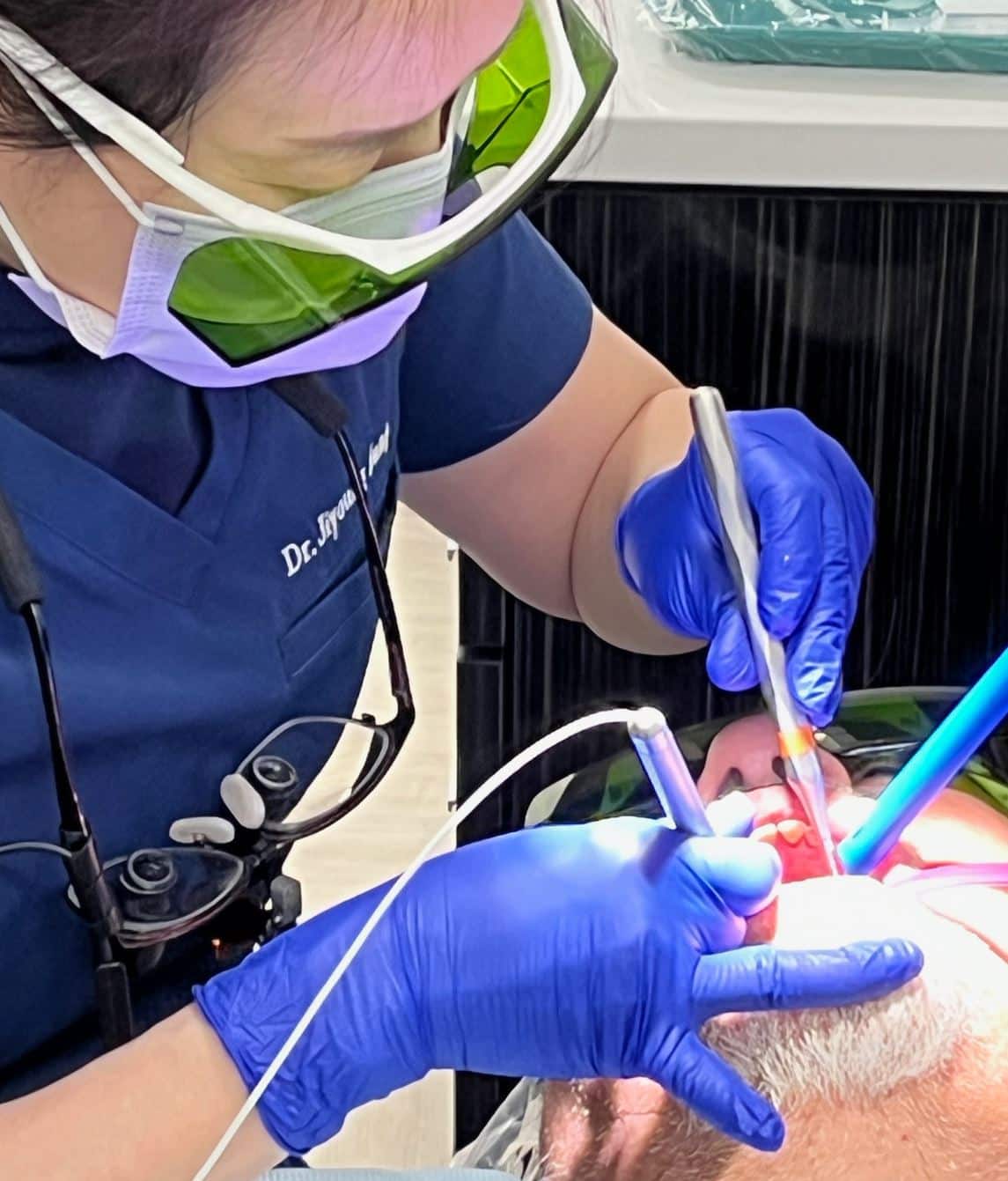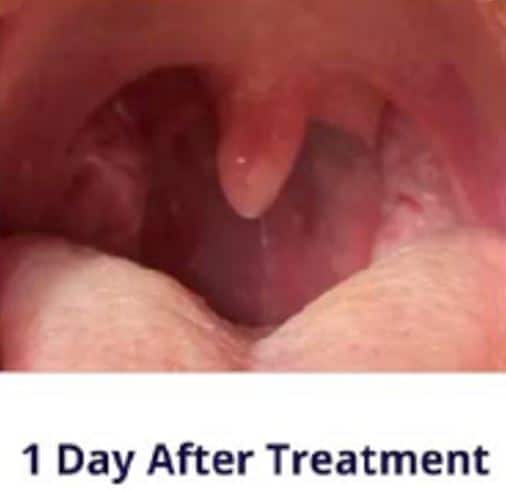
At Central Park Dental in Mansfield, Texas, Dr. Jiyoung Jung is committed to providing advanced treatment options for patients of all ages. Among these innovative procedures is laser frenectomy—a modern, minimally invasive approach to treating lip ties. This comprehensive guide explores what lip ties are, why laser treatment is an effective solution, and how Dr. Jung’s expertise can help patients achieve improved oral function and health.
What Is a Lip Tie?
A lip tie, medically known as a labial frenulum restriction, occurs when the thin membrane of tissue (frenulum) connecting the upper lip to the gums is too tight, short, or thick. This tissue is present in everyone, but when it’s restrictive, it can cause various functional and developmental issues.
The labial frenulum serves as a natural anchor, but when it’s restrictive, it may limit proper lip movement. This restriction can affect individuals from infancy through adulthood, though it’s often first identified in babies who struggle with breastfeeding.
Types of Lip Ties
Lip ties are classified based on their attachment point and severity:
Class I: Attachment to the gingival margin (mild) Class II: Attachment to the attached gingiva (moderate) Class III: Attachment extending to the papilla between the front teeth (moderate to severe) Class IV: Extension into the hard palate (severe)
Each classification requires different approaches for treatment, with more severe cases often causing more noticeable symptoms and functional limitations.
Signs and Symptoms of Lip Ties
Recognizing a lip tie is the first step toward appropriate treatment. The signs and symptoms vary by age group:
In Infants:
- Difficulty latching during breastfeeding
- Poor weight gain despite frequent feeding attempts
- Clicking sounds during feeding
- Gassiness and reflux symptoms
- Maternal discomfort during breastfeeding
- Inability to maintain suction while feeding
- “Heart-shaped” appearance of the upper lip when raised
In Children:
- Speech difficulties, particularly with certain consonants
- Gaps between front teeth (diastema)
- Food collection between the lip and gums
- Difficulty cleaning the area between the gums and upper lip
- Increased risk of tooth decay in front teeth
- Challenges with certain lip movements
In Adolescents and Adults:
- Persistent gap between front teeth
- Difficulty with oral hygiene in the upper gum area
- Receding gums around front teeth
- Sensitivity or discomfort in the frenulum area
- Limitation in fully smiling or making certain facial expressions
At Central Park Dental, Dr. Jung performs thorough evaluations to identify lip ties and determine if treatment would be beneficial for improving oral function and overall health.
The Impact of Untreated Lip Ties
When left untreated, lip ties can lead to various complications that affect oral health and function throughout life:
Dental Concerns:
Untreated lip ties often lead to a persistent gap between the front teeth. While some spaces between teeth are normal in developing children, a gap caused by a lip tie typically won’t close naturally over time. The restricted frenulum can also pull on the gingival tissue, potentially leading to gum recession around the front teeth and increasing the risk of dental decay due to food particles becoming trapped.
Speech Development:
The limited mobility of the upper lip can affect proper pronunciation of certain sounds, particularly labial sounds that require full lip movement. This can lead to speech delays or articulation challenges that may require speech therapy interventions.
Feeding Challenges:
Beyond infancy, restrictive lip ties can continue to affect eating habits. Children may struggle with certain foods or develop compensatory eating patterns that can affect their nutritional intake and enjoyment of meals.
Oral Hygiene Complications:
The restricted area between the lip and gums can be difficult to clean properly, creating a pocket where plaque accumulates. This increases the risk of cavities and gum disease, even in individuals with otherwise good oral hygiene practices.
Psychological Effects:
Aesthetic concerns related to gaps between teeth or limitations in facial expressions can affect self-confidence, particularly in adolescents and adults. These concerns shouldn’t be dismissed, as they can impact social interactions and self-image.
Traditional vs. Laser Treatment for Lip Ties
Historically, lip ties were treated using surgical scissors or a scalpel in a procedure known as a frenotomy or frenectomy. While effective, these traditional methods have several limitations when compared to modern laser treatment:
Traditional Methods:
- Typically require local anesthesia
- Often involve sutures
- Generally cause more bleeding during the procedure
- May result in more post-operative discomfort
- Usually have longer healing times
- Higher risk of infection and scar tissue formation
Laser Treatment Benefits:
- Minimal or no bleeding during the procedure
- Precise tissue removal with less trauma
- Sterilizes the area during treatment, reducing infection risk
- Significantly reduced post-operative discomfort
- Faster healing time with less inflammation
- Often requires no sutures
- More comfortable experience for patients of all ages
At Central Park Dental, Dr. Jung utilizes advanced laser technology for frenectomy procedures, providing patients with the most comfortable and effective treatment experience possible.
The Laser Frenectomy Procedure at Central Park Dental
Under Dr. Jung’s expert care at Central Park Dental, laser frenectomy is a precise, efficient procedure that typically takes less than 30 minutes from start to finish. Here’s what patients can expect:
Pre-Procedure Evaluation:
Dr. Jung begins with a comprehensive examination to confirm the diagnosis of a lip tie and determine if a laser frenectomy would be beneficial. This includes assessing the classification of the tie, discussing symptoms, and considering the patient’s age and specific needs. For infants, Dr. Jung may coordinate with lactation consultants or pediatricians to ensure a collaborative approach to care.
During the Procedure:
- For infants and young children, a topical numbing gel may be applied to ensure comfort. Older children and adults typically receive local anesthesia.
- Protective eyewear is provided to all present in the treatment room, as required for laser procedures.
- Dr. Jung uses the dental laser with precision to release the restricted frenulum tissue. The laser energy vaporizes and removes the restrictive tissue while simultaneously sealing blood vessels and nerve endings.
- The procedure itself usually takes just a few minutes, with the laser precisely targeting only the necessary tissue while preserving healthy surrounding structures.
- The treated area is gently cleaned, and post-operative instructions are provided.
Post-Procedure Care:
After the laser frenectomy, patients or caregivers receive detailed instructions for home care, which typically includes:
- Gentle stretching exercises to prevent reattachment during healing
- Oral hygiene practices appropriate for the age of the patient
- Pain management recommendations (usually minimal over-the-counter options are sufficient)
- Feeding guidelines for infants
- Follow-up appointment scheduling to monitor healing progress
For infants specifically, Dr. Jung often recommends immediate feeding following the procedure, as this can provide comfort and begin the process of developing new, improved feeding patterns.
Why Choose Laser Treatment at Central Park Dental?
Dr. Jung’s approach to laser frenectomy at Central Park Dental offers several distinct advantages:
Advanced Technology:
The dental lasers used by Dr. Jung represent the cutting edge of dental technology, providing treatment that’s far more comfortable and effective than traditional surgical approaches. This technology allows for precision that wasn’t possible with conventional methods.
Expertise and Experience:
Dr. Jung has extensive training in laser dentistry and regularly updates her knowledge of the latest techniques. Her gentle approach and understanding of oral development across the lifespan make her particularly well-suited to perform this procedure on patients of all ages.
Comprehensive Care:
At Central Park Dental, lip tie treatment isn’t just about the procedure itself—it’s about addressing the whole patient. Dr. Jung works collaboratively with other healthcare providers when needed and ensures that patients receive support throughout the entire treatment process, from evaluation to follow-up care.
Comfortable Environment:
The Central Park Dental office in Mansfield is designed to provide a calming, comfortable atmosphere for all patients. This attention to environmental details helps reduce anxiety and contributes to a positive treatment experience.
Recovery and Expected Results After Laser Frenectomy
Most patients experience remarkably quick recovery following a laser frenectomy performed by Dr. Jung. Here’s what to expect during the healing process:
Immediate Post-Procedure Period:
- A white or yellow fibrin patch forms over the treatment area—this is a normal part of healing and not a sign of infection
- Minimal discomfort that can typically be managed with over-the-counter pain relievers if needed
- For infants, some initial adjustment in feeding patterns may occur
First Week of Recovery:
- The initial fibrin patch begins to disappear
- Stretching exercises help prevent reattachment of the tissue
- Gradual improvement in function and comfort
- Follow-up appointment to assess healing progress
Long-Term Results:
The benefits of laser frenectomy become increasingly apparent as healing progresses:
- For infants: Improved latch and more efficient feeding, often with notable improvements in weight gain patterns and reduced symptoms of gas or reflux
- For children: Enhanced articulation, easier oral hygiene practices, and potential improvement in dental alignment
- For adults: Better gum health around front teeth, improved comfort, and often aesthetic improvements in smile appearance
It’s important to note that for some patients, particularly those with longstanding speech adaptations or established compensatory patterns, additional therapies may be recommended to achieve optimal results. Dr. Jung can provide referrals to speech therapists or myofunctional therapists when appropriate.
Frequently Asked Questions About Laser Lip Tie Treatment
At Central Park Dental, Dr. Jung often addresses these common questions about laser frenectomy:
Is laser frenectomy painful?
The procedure itself involves minimal discomfort thanks to appropriate use of anesthetics and the precise nature of laser technology. Most patients experience far less post-operative pain than with traditional surgical approaches.
What age is best for having a lip tie treated?
While lip ties can be treated at any age, earlier intervention often leads to better outcomes with fewer compensatory patterns to overcome. For infants experiencing feeding difficulties, treatment is often recommended as soon as the issue is identified. For older children and adults, the decision is based on symptoms and functional limitations rather than age alone.
Will dental insurance cover laser frenectomy?
Coverage varies by insurance provider and plan. At Central Park Dental, our administrative team can help patients understand their coverage options and, if necessary, discuss alternative payment arrangements to ensure access to appropriate care.
How soon after a laser frenectomy will improvements be noticed?
Many patients, particularly infants with feeding difficulties, experience immediate improvements. For others, benefits develop gradually as healing progresses and new movement patterns are established. The full benefits are typically realized within a few weeks of the procedure.
Are there any risks associated with laser frenectomy?
When performed by a skilled practitioner like Dr. Jung, laser frenectomy carries minimal risks. The most common concern is reattachment of the tissue, which is why post-procedure stretching exercises are so important. Serious complications are exceedingly rare with modern laser techniques.
Preventive Oral Health and Frenulum Assessment
At Central Park Dental, Dr. Jung emphasizes the importance of early assessment and preventive care. Regular dental check-ups from an early age allow for timely identification of potential lip tie issues before they lead to more significant problems.
For parents of newborns and young children, Dr. Jung offers gentle evaluation of oral structures, including the labial frenulum, as part of comprehensive preventive care. This proactive approach helps identify potential concerns early when intervention can be most effective and least invasive.
For patients using preventive oral devices, Dr. Jung can assess whether a restrictive frenulum might be affecting proper device fit or function, ensuring optimal results from preventive treatments.
The Central Park Dental Difference
At Central Park Dental in Mansfield, Texas, Dr. Jiyoung Jung combines clinical excellence with compassionate care. Her approach to laser frenectomy exemplifies the practice’s commitment to:
- Utilizing advanced technology for optimal patient outcomes
- Providing comfortable, minimally invasive treatment options
- Taking time to thoroughly educate patients about their conditions and treatment options
- Creating individualized treatment plans that address each patient’s unique needs
- Offering comprehensive follow-up care to ensure successful results
Whether you’re a new parent concerned about your infant’s feeding difficulties, seeking solutions for a child with speech or dental development issues, or an adult experiencing discomfort or oral health challenges related to a lip tie, Dr. Jung provides expert assessment and treatment in a supportive environment.
Taking the Next Step: Schedule Your Consultation
If you suspect that you or your child may be affected by a lip tie, the first step is a thorough evaluation. Dr. Jung and the team at Central Park Dental are ready to provide the information, support, and treatment you need.
To schedule a consultation, call our Mansfield office at 817-466-1200 or schedule your consultation. Our friendly staff will help you find an appointment time that works with your schedule and answer any initial questions you may have about laser frenectomy or other services.
Early intervention can prevent many of the long-term complications associated with lip ties, so don’t delay in seeking professional assessment. At Central Park Dental, we’re committed to helping patients of all ages achieve optimal oral health and function through advanced, compassionate care.
Located in the heart of Mansfield, Central Park Dental welcomes patients from throughout the surrounding communities. Dr. Jung and her team look forward to helping you discover the difference that expert laser treatment can make in addressing lip ties and improving overall oral health.


